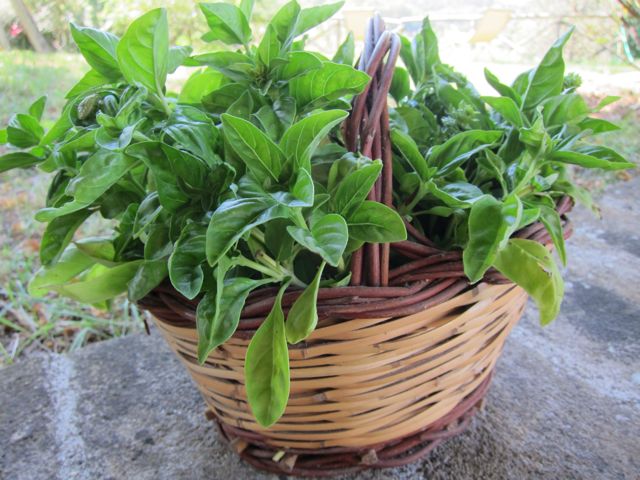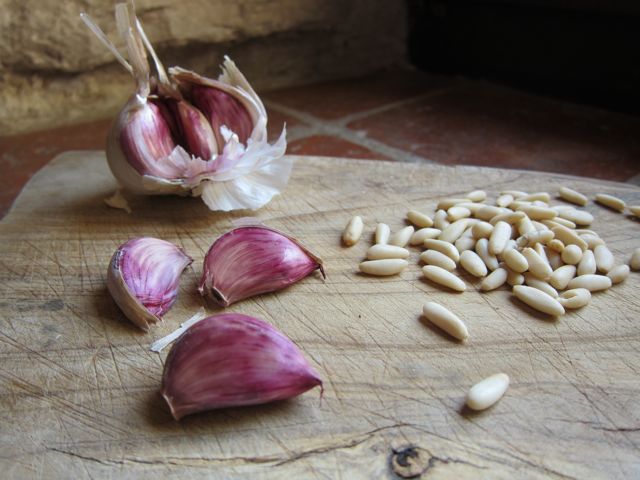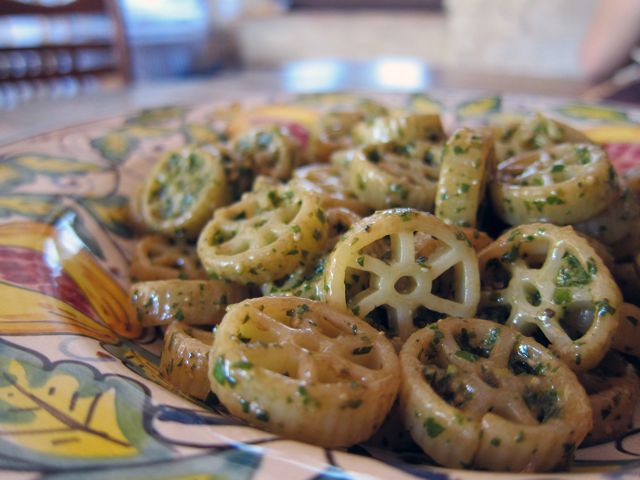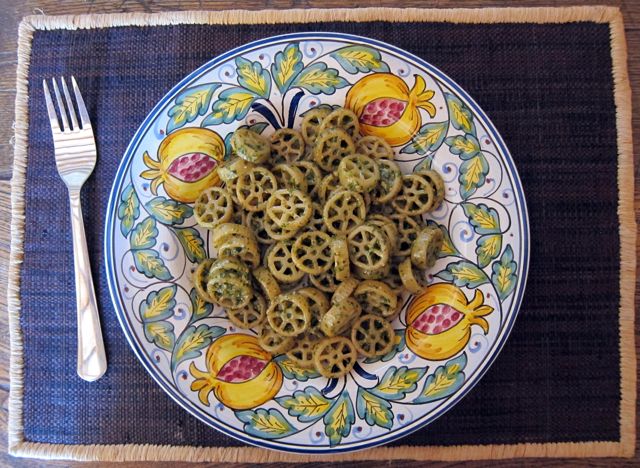
It happens every year. I plant tons of tiny basil plants, then worry that I won’t have enough basil to see me through the summer. I plant basil on the terrace in Rome, in pots outside the kitchen door in Todi as well as straight in the ground in the vegetable garden. All June and July I carefully nip the flowers off the plants so that they will continue to produce big green leaves.
But I’m always stingy in terms of what I pick. Just enough leaves to get me through a recipe. And I would almost never think of picking enough to make pesto. Because then what would happen if I ran out?
Which is really stupid, since I’m basically growing bushes of the stuff.
This all becomes apparent by the end of August when I have enough basil to go into the pesto-making business. Which is pretty much what I start to do. I finally realize that the basil plants won’t last forever, and I better harvest them while they are at their peak. At which point I make up enough basil to see us through the winter.
Although I’m sure I started out making pesto by looking at a recipe. (Marcella Hazan no doubt) by now I can do it blindfolded. Really. Pesto is that easy. There are only five main ingredients, and even if you mess up the quantities a bit, it always tastes extraordinary.
The trick, of course, is to make sure your basil is just picked, if possible. And good olive oil goes without saying.
The traditional recipe calls for pinoli. And the pesto is even better if you lightly toast the nuts first. (But if you don’t feel like it, that’s ok too.) Also, if you don’t happen to have pine nuts, or don’t want to spend the money, you can substitute other nuts as well. Sicilians use pistachios, and I often use almonds. My friend Sienna swears by pecans.
So now my beautiful basil plants are pretty much picked clean. But my freezer is full of bright green jars of pesto. A little summer sunshine to see us through the winter. 

Pesto
(enough to coat 1/2 kilo/ 1 pound pasta)
(I’m sure pesto tastes even better when made with a motar and pestle. But…I’m lazy. )
2 1/2 cups basil leaves
1/4 cup pine nuts (lightly toasted if possible)
1/3 cup olive oil
1-2 cloves garlic
1/3 cup grated parmigiano
salt & pepper
Place basil, garlic and pine nuts in a food processor, with a few pinches of salt and a few grindings of pepper. Pulse on high speed until finely chopped. With motor running, slowly pour in the olive oil. Blend until smooth.
Scrape the pesto out into a bowl and stir in the parmigiano. Taste and adjust for salt.
If you are going to use it that same day, place a piece of saran wrap on top of the pesto, pressing it down to cover it all. This is so it doesn’t oxidize and turn dark. If you’re going to use it in the next few weeks, float a half centimeter of oil on top, cover, and store in fridge.
If you are going to freeze it, place in a jar, float oil on top, and freeze.
Pasta al Pesto
serves 4
1/2 kilo / 1 pound pasta
1 recipe Pesto
Bring large pot water to boil. Add salt, and cook pasta until done. Drain, reserving a half cup of the cooking water.
Place pesto, which should be room temperature, in a large serving bowl. Add a few tablespoons of the pasta water to the pesto, stir to thin out a bit. Add pasta and toss. If it seems dry, add a bit more water.
Wagon wheel pasta! Yayyyyyyyy!
May I suggest to use “pecorino” instead of parmigiano? It gives a stronger flavor to the recipe. Buon appetito!
Ciao Elizabeth!
The issue mortar vs. blender used to creep up at the dinner table in Genova each time pesto would be served. There is no final answer, but most agree that had a blender been available in the old days, cooks in Genova would have gladly used one!
Interesting Eliana’s comment on pecorino: my father used a blend of 1/3 pecorino, 2/3 parmigiano.
Garlic: there is a lot of people who prefer pesto without garlic, or with very little garlic, like 1/4 of a clove.
An antique version of pasta al pesto was with potatoes and string beans.
You peel some potatoes (1 medium for 2 persons) and slice them medium, about 3 or 4 mm thick. You take some frozen string beans (100 gr every 2 persons?) and throw them with the sliced potatoes in the cold pasta water, then you put the water on fire.
When it boils, you throw the pasta (traditionally bavette or linguine).
When pasta is ready, you drain it together with beans and potatoes, and mix with the pesto sauce, adding a bit of the cooking water you kept by the side (very important detail!!)
Enjoy!
Adding string beans…what a great idea!!
@Ruth: Sophie chose the pasta shape. Wagon wheels a favorite.
@Eliana: I often use pecorino for, as you suggest, a stronger flavor.
@Voscia61: I love adding potatoes and/or string beans.
@Chefbea: you should do it!
@ Eliana: I also prefer pecorino to parmigiano in my pesto.
@Elizabeth: In a pinch, I have uses walnuts in my pesto, which is also very nice. I typically freeze my pesto in ice cube trays, and place in a zip lock bag when frozen.
I use half pecorino and half parmigiano and never skip the garlic. Many sayings on “pesto w/o garlic” in Italy…Like it’s a marriage w/o sex or something like that :))
I like Marcella’s advice about freezing the pesto without the cheese. I prefer a mix of pecorino, not Locatelli, and Parmigiano. It tastes more like Liguria.
Also I suggest smooshing the garlic into paste with the side of a knife and some salt to break it down. Your Italian friends will appreciate that they are not meeting any garlic “Sotto Dente” in their Pesto.
Homemade pesto is the best. I store it in ziplock plastic bags. Flatten the bags and remove all air. Once frozen, you can stack the bags and break of just what you need for cooking without defrosting the whole thing.
@Donna: Great idea!
love your blog, Elizabeth. I’ve been sitting here in Maine dreaming I’m in Italy….
@Gail: Thanks, happy to help with the dreams.